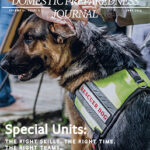The integration of emerging technologies in emergency management holds the promise of enhancing response efficiency and accuracy. However, these technologies are challenging, particularly regarding legal and privacy concerns. As emergency managers adopt tools like data analytics, surveillance systems, and biometric identification, navigating the complex landscape of laws and regulations to protect individuals’ rights is imperative. Part 5 of this five-part series delves into the legal and privacy issues inherent in emergency managers’ use of emerging technology.
Examples of Legal Concerns
Using emerging technologies often entails collecting extensive data, ranging from geolocation information to health data. The crux of the issue lies in how users amass, store, and utilize this data while respecting individual privacy rights. For example, emergency managers might aggregate location data from individuals’ smartphones during a crisis to gauge population movement patterns for effective resource allocation. However, the challenge arises when such data is gathered without explicit consent, potentially encroaching upon individuals’ privacy.
Here are examples of how authorities having jurisdiction have successfully implemented technology:
- Singapore has implemented an extensive network of surveillance cameras and sensors to monitor traffic and public spaces. These sensors are used for traffic management, crime prevention, and emergency response.
- Barcelona, Spain, has deployed smart street lighting with integrated sensors to monitor noise levels, air quality, and traffic. This data is used to improve public safety and urban planning.
- In Chicago, Illinois, a predictive analytics platform called “ShotSpotter” uses internet of things (IoT) sensors to detect and locate gunfire in real-time. This technology helps law enforcement respond more effectively to gun violence.
- Dubai, UAE, uses IoT-based smart traffic management systems to improve road safety and reduce congestion. These systems include traffic cameras, smart traffic signals, and automated incident detection.
- The New York City Police Department (NYPD) uses facial recognition technology in criminal investigations and public safety efforts.
- The London Metropolitan Police (London Met) has experimented with facial recognition technology in public spaces to identify persons of interest.
- Los Angeles Police Department (LAPD) in California explored predictive policing methods to allocate resources more effectively in crime-prone areas.
- Chinese police in Shanghai use facial recognition technology to monitor public spaces and identify suspects.
The deployment of surveillance and monitoring technologies like drones, cameras, and sensors for emergency response raises concerns regarding the inadvertent monitoring of individuals. Balancing public safety imperatives with privacy rights is delicate . For example, authorities might employ drones to monitor public spaces to enforce social distancing during a health crisis. However, constant surveillance potentially infringes upon individuals’ right to privacy.
Adopting biometric data, like facial recognition or fingerprints, for emergency identification introduces ethical and legal difficulties. Safeguarding the collection and storage of biometric information is pivotal. For example, facial recognition technology could expedite aid distribution by identifying displaced individuals in emergency shelters. However, mismanagement of this technology might lead to privacy breaches and identity theft.
The storage and transmission of voluminous sensitive data introduce the risk of data breaches, jeopardizing individuals’ personal information. For example, an emergency management system storing medical records and contact details could become a prime target for cyberattacks, resulting in unauthorized access to sensitive information.
The ethical use of emerging technologies necessitates transparent communication with the public regarding data collection practices and intended uses. For example, should emergency managers deploy a mobile application for real-time communication during crises, they should inform users about the data types collected and their purposes.
Balancing the Advantages and Challenges
Applying emerging technologies in emergency management offers unprecedented advantages but comes with legal and privacy challenges. Striking a balance between harnessing these tools and safeguarding individuals’ rights demands a collaborative approach involving emergency management experts, legal professionals, policymakers, and technologists. By staying attuned to evolving laws and regulations, stakeholders will ensure that technological advancements fortify response efforts while upholding the principles of privacy and data protection.
This five-part series is intended to expand the knowledge base about emerging technologies, how they can improve emergency management practices, and the challenges they can pose to jurisdictions and individuals. As any professional knows, the secret to success is the network’s depth and relationships with colleagues – for example:
- The comptroller or treasurer will help design a budget to fund the purchasing of these technologies.
- Use your corporate legal counsel to guide you around the privacy and legal landmines.
- The IT (or “6” shop for military personnel) Department will help safely incorporate technologies into information systems.
- Peers in fire, EMS, law enforcement, public health, health care, and public works will help implement these technologies.
During the “blue sky” days, take the time to build these professional relationships, research the benefits and potential pitfalls, and build capabilities to protect communities before the next disaster.
Links to other articles in this series:
Part 1 – Information and Communication
Part 3 – Artificial Intelligence and Machine Learning
Part 4 – Robotics and Automation

Ian Pleet
Ian Pleet is committed and dedicated to serving as an outstanding example of an emergency management professional with over thirty years of hands-on expertise. He is widely recognized as an adept manager of high-risk emergencies, with a strong focus on addressing chemical, biological, radiological, nuclear, and explosive threats (CBRNE), as well as weapons of mass destruction (WMD) and infectious diseases. His record of accomplishment is marked by the successful design and execution of exercises, delivering adult education using high-fidelity simulations, and establishing effective incident management systems during emergency responses. Moreover, Mr. Pleet is renowned for his ability to advocate policy and oversee program reviews, and he is considered an authority in risk management. He plays an active role in emergency management as an instructor for emergency management and incident command courses, contributing to industry publications and providing technical oversight for textbooks before publication. He is a pro-board-certified fire officer IV, FEMA Professional Continuity Practitioner, and DoD Antiterrorism Officer.
- Ian Pleethttps://www.domesticpreparedness.com/author/ian-pleet
- Ian Pleethttps://www.domesticpreparedness.com/author/ian-pleet
- Ian Pleethttps://www.domesticpreparedness.com/author/ian-pleet
- Ian Pleethttps://www.domesticpreparedness.com/author/ian-pleet






